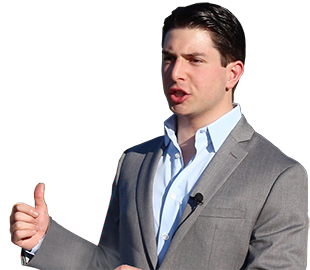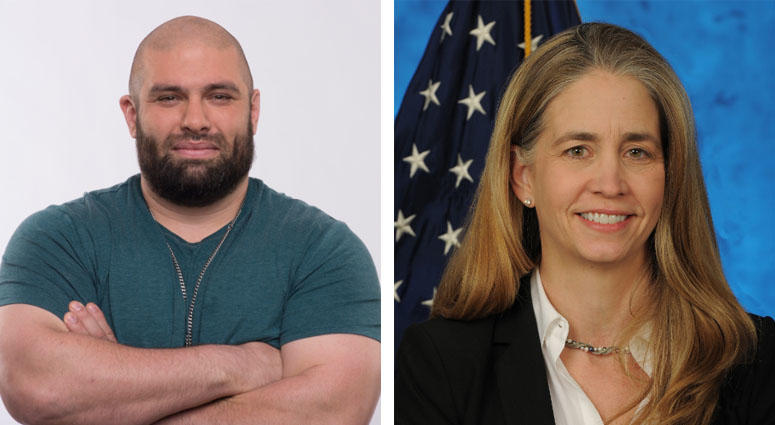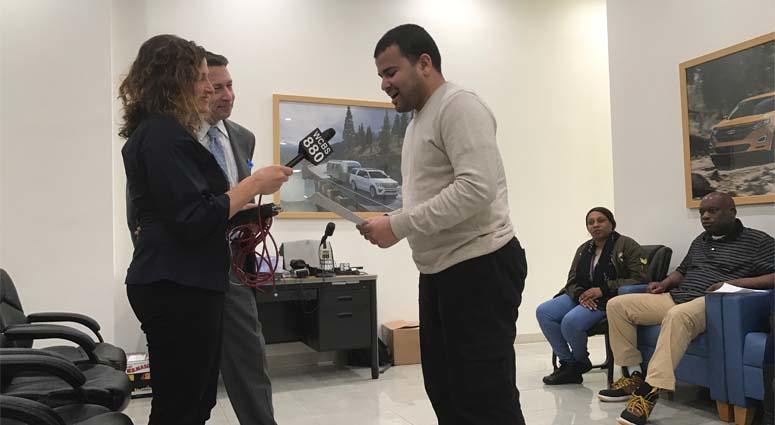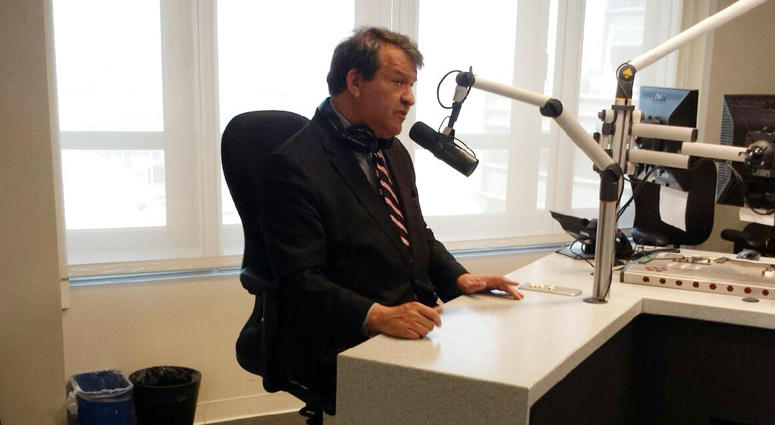
-
Campaign Urges Veterans To Get Mental Health Care If They Need It
Post Views: 1,257NEW YORK (WCBS 880) — May is Mental Health Awareness Month, and the U.S. Department of Veterans Affairs has launched a campaign to urge veterans to get help for if they need it.
The campaign is called “Mental Health Means a Stronger You.” It aims to reshape the perceptions and treatment by outlining the success stories of vets who have reached out for mental health support.
WCBS 880 Producer Neil A. Carousso talked about the campaign this week with Marine Corps veteran Moses Maddox – now veterans retention counselor at California State University San Marcos – and Dr. Wendy Tenhula, director of innovation and collaboration at the U.S. Department of Veterans Affairs.
It is part of the “Make a Connection” program, the VA’s ongoing national mental health outreach effort.
“While the conversation for mental health has gotten better, there’s still this stigma that, you know, either you’re weak or you’re crazy – a variety of things that people say when it comes to seeking, you know, mental health, that frankly just aren’t true, and that treatment is something that should be thought out, and that recovery can be achieved as long as you take your treatment seriously and as long as you actually go out there and seek that help,” Maddox said.
Maddox said some veterans might not seek out mental health care because of the stigma, some are concerned that it might limit their employment opportunities, and some don’t want to admit they need help because they feel like they can go through anything after having gone to war.
“And then they come home, and something as simple as a college class is extremely difficult because they’re cycling through things,” Maddox said. “So there’s a variety of reasons why people don’t go seek help, and this movement that we’re trying to do; this message is to say, ‘Hey, OK, people have been there before. We’ve gone through it. You’re not alone. Don’t be afraid to open yourself up and get that help.”
Tenhula said the “Make a Connection” program was launched a few years ago “to raise awareness about mental health conditions and to inform veterans, as well as their family members and other loved ones, as well as their country at large, that mental health conditions are treatable.”
She said hundreds of veterans have come forward and talked about their own difficulties, the treatments they have received, and how those treatments have made a difference.
“There are effective treatments available, and that recovery is possible,” Tenhula said.
Maddox said there are many factors that go into an effective mental health care treatment program.
“One is having a really good counselor who is very honest about the process; who told me that some days are going to be better than others; that there’s going to be sessions where I might leave the session feeling worse than when I started, but it was all part of the process,” he said.
He added that the first step is just to get help and understand that doing so can be scary and stressful – particularly since a therapist will start out as a stranger to whom a veteran is assigned.
“But keep in mind that it is OK; that it is a process, and you have to stick with it. There’s going to be days where it’s incredibly difficult. There’s going to be times when it’s going to be hard to go out of bed, and there’s always an excuse; a reason not to go. You have to not listen to that,” Maddox said. “Once you take that first step, you have to follow through, and those stressors tend to go away once you get comfortable with the process; once you start to see little incremental changes.”
The VA has also expanded the methods veterans can use to access mental health care, Tenhula said
“We’ve expanded the use of telehealth for mental health conditions, so a veteran can be in one location, and their doctor or therapist can be in another location, and they can work together using video conferencing technology. VA also has a number of mental health-related mobile phone apps,” she said.
Maddox’s message for other veterans was that he has an idea of what they’re going through – and he said veterans like openness, honesty, and frankness.
“It’s natural. But you’re not weak for going to seek out mental health treatment, and in fact, saying that I do need help is a great sign of strength, and that’s what we really encourage,” Maddox said.
-
City Council Staffers Get Naloxone Training As Protesters Demand Safe Injection Sites
Post Views: 1,496NEW YORK (WCBS 880) — City Council staffers were trained on how to prevent opioid overdose deaths as protesters staged an act of civil disobedience to get Mayor Bill de Blasio to act on so-called safe injection sites.
City Councilwoman Diana Ayala, who represents the South Bronx, organized the training session, hoping staffers would take the information out into the community.
“It’s a very personal subject matter for me as the family member of several individuals who are drug addicted and who have come close to overdosing,” Ayala said.
#savealife NYC Alliance for Positive Change distributes #NARCAN kits and shows city council members how to use them. @wcbs880 pic.twitter.com/0MnCGsvBnR
— Marla Diamond (@MDiamond8) May 2, 2018
Staffers received training and naloxone kits from Reilly Glasgow with the Alliance for Positive Change who has saved over 50 lives using Narcan at the East Side Harm Reduction Center.
“I say this in joking but I’m jaded, this is something that you do all the time, you don’t even think about it. You just hope you’re not too late,” Glasgow said.
About a dozen arrested including City Councilman Steve Levin for blocking lower Broadway demanding sites where opioid users are monitored. @EndOverdoseNY @wcbs880 #opioidcrisis pic.twitter.com/4kTBSBPQj3
— Marla Diamond (@MDiamond8) May 2, 2018
As the training was held on the 16th floor at 250 Broadway, on street level more than a dozen people, including Brooklyn City Councilman Steven Levine, were arrested for sitting in a crosswalk, blocking traffic near City Hall.
They are demanding that de Blasio release the results of a City Hall-commissioned study on so called “safe consumption sites” where users are monitored.
https://twitter.com/mdiamond8/status/991694382284845061?s=21
“Nobody has ever died of an overdose in a single one of them, you know, we can’t really understand what’s complicated about the best public health intervention for saving lives,” said melissa more is with the drug policy alliance.
“The mayor’s basically saying that it’s complicated, he wants to have everything in a row before he releases the report but while he’s doing that people are still dying,” said Hiawatha Collins with the Harm Reduction Coalition. “At the end of the day it’s not about politics, it’s not about where people are going in their position and elevating themselves, it’s about saving lives.”
Canada and Europe have long had monitored injection sites. There are none in the United States.
Neil A. Carousso produced Marla Diamond’s report for WCBS Newsradio 880.
-
E-Cigarettes Pose Plenty Of Their Own Risks, Expert Says
Post Views: 1,909MIDDLESEX, N.J. (WCBS 880) — The health risks of cigarettes are well-known, and now the new trend among teens is vaping – using e-cigarettes that contain nicotine and other chemicals.
E-cigarettes employ liquid chemicals turn into a vapor that people inhale, and many are now warning that they have plenty of their own risks – particularly for teenagers.
E-cigarette manufacturer JUUL says it will spend $30 million to keep its products away from underage users, just as the Food and Drug Administration announced a crackdown of underage use of vaping devices.
Dr. Indra Cidambi is a leading addiction expert and the founder of the Center for Network Therapy – New Jersey’s first state-licensed ambulatory detoxification treatment facility. She told WCBS 880 Producer Neil A. Carousso that the push JUUL is not a victory in any way.
“It’s not at all, because this understanding; this belief, I would say, that e-cigarettes are safer – it is not. Nicotine is highly addictive, and it can prime the brain’s reward system for addiction to other drugs. So e-cigarettes to graduating to the use of other drugs is quite possible,” she said. “So if you really look at the statistics, it says one in four teenagers who reported e-cigarette use eventually progressed to smoking pot; smoking marijuana, as compared to one in 12 of teenagers who did not use e-cigarettes.”
Cidambi also noted that some teens are “dripping,” that is, pulling an e-cigarette apart and placing e-liquid drops that contain nicotine and flavoring agents directly onto the heated coil while inhaling quickly. The practice creates a thicker vapor, enhances the flavor, and creates a stronger “throat hit” – the pleasurable sensation that that inhaling the vapor brings about in the throat.
“We need to look more into this,” she said. “The dripping is really bad.”
Cidambi said some e-cigarettes can deliver 20 times the nicotine of one cigarette. She explained that the nicotine goes into the bloodstream and stimulates the adrenal gland – a process that in turn releases epinephrine. The epinephrine stimulates the central nervous system and increases blood pressure, the heart rate, and the rate of breathing.
The stimulation also results in an increase of dopamine, which goes to the brain’s reward system. The reward system is also stimulated by food, sex, and other drugs.
“Once that gets triggered, the plain old addictive cycle starts out,” Cidambi said.
Cidambi also said even among adult users, many are switching from regular cigarettes to e-cigarettes – but are not using them as a tool to stop altogether.
“It’s not like, ‘I used e-cigarettes for a little bit and got off the thing’ – no, not at all. Instead of cigarettes, now they’re smoking e-cigarettes. That’s the only positive thing that we can say,” she said.
But e-cigarettes have their own health risk, Cidambi emphasized. Their vapor has been found to contain some carcinogens, and some brands contain high levels of metals such as nickel and chromium that are “not healthy,” she said.
In dripping, low levels of cadmium are also involved and can cause breathing problems, she said.
“I don’t think this is in the right direction – like, we shouldn’t promoting any of these. Smoking is bad, you know,” Cidambi said. “Leading a healthy life is important.”
Meanwhile, Harvard Medical School recently published data showing that nicotine poisoning from e-liquid has skyrocketed. Between the flavoring and attractive packaging, there has been a 1,500 percent increase in accidental ingestions of e-liquid among toddlers and young children over the past three years, the study said.
Cidambi said rationalizing that e-cigarettes are relatively safer than regular cigarettes is the wrong road to go down.
“It’s disheartening to see how our culture is changing now. Our community is accepting those ideas – started comparing all the time what you hear from people who are smoking, they would always say, ‘Smoking weed is not as bad as alcohol use,’ so it’s always a comparison. And, ‘Oh, e-cigarettes are better than cigarettes,’” she said. “So it’s the same – ‘This is not as bad as that.’ That’s not a good comparison. I always say to my patients, ‘Why don’t you compare yourself to people being totally abstinent and not using anything?’ And then they just keep quiet.”
Cidambi also emphasized that pregnant women should not be using e-cigarettes or smoking anything at all, and prescription medications also may be risky for pregnant women.
-
Young People with Autism Get To Be WCBS 880 Reporters For A Day
Post Views: 1,927NEW YORK (WCBS 880) — As part of Autism Awareness Month, and in partnership with Koeppel Auto Group, WCBS Newsradio 880 presented a program on news and weather reporting for a class of autistic young people from the Quality Services for the Autism Community Day Habilitation program.
The young people came to the showroom of Koeppel Ford in Woodside, Queens to hear from WCBS 880 Reporter Marla Diamond and Chief Meteorologist Craig Allen.
Diamond explained how she works as a reporter – including her early alarm clock, her computer skills, how she works out of her vehicle, and how she travels the city covering all kinds of interesting stories.
She demonstrated how she uses as microphone, digital recorder and audio editing software on her laptop. She recorded QSAC visitors reading news scripts and weather forecasts.
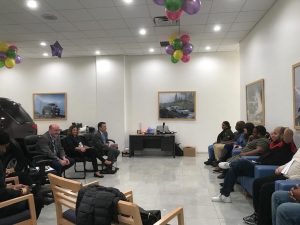
WCBS Newsradio 880 Director of News and Programming Tim Scheld, Reporter Marla Diamond and Chief Meteorologist Craig Allen talk with motivated QSAC students. (Neil A. Carousso/WCBS 880) The QSAC young people also got a lesson in weather from Allen, a veteran of both radio and TV. He also brought tools of his trade — including a barometer, a lightning detector, and something that created a tornado effect in a glass tube.
The session concluded with questions and answers from the young people about everything from covering snow storms to what makes a good news story.
“So when we talked to the guys who came today about this potential opportunity, they were incredibly excited to meet people in the community who they see as absolute superstars, and they really were excited to learn about what you guys do, and to be in a place with fancy cars, with everybody giving them tons of attention, so they’re really excited to be a part of this today,” said QSAC Senior Director of Day Services Lauren Maldonado.
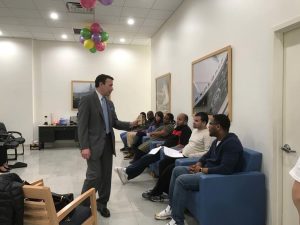
WCBS Newsradio 880 Chief Meteorologist Craig Allen shows QSAC students the tools of his trade. (Neil A. Carousso/WCBS 880) QSAC President and Chief Operating Officer Cory Polshansky said many in the program are making leaps and bounds toward independence. He mentioned one young man who has been with the program since he was a teenager.
“Now it’s 15 years later, and he’s grown into a young adult, and he’s developing the skills and hopes to one day live in his own apartment. And that’s what he’s been talking about for a couple of years, and he’s working at it, and in a couple years, he’ll probably be ready to live independently with some supports from QSAC,” Polshansky said.
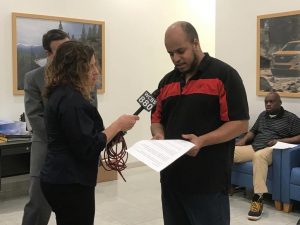
A QSAC Student reads a weather forecast with WCBS Newsradio 880 Reporter Marla Diamond and Chief Meteorologist Craig Allen. (Neil A. Carousso/WCBS 880) The session was held at the Koeppel showroom in Queens as part of the auto group’s strong support of the QSAC organization.
“We would like to give back what we get. I mean, it’s kind of selfish to keep getting and not giving back,” Koeppel said.
Neil A. Carousso produced WCBS Newsradio 880’s digital content at QSAC’s Day of Habilitation program at Koeppel Auto Group on Friday, April 13, 2018.
-
After 100 Days In Office, Westchester County Executive Says Budget Is Top Concern
Post Views: 1,349NEW YORK (WCBS 880) — George Latimer is marking 100 days in office as Westchester County Executive.
The Democrat was elected last fall, unseating two-time popular incumbent Republican Rob Astorino. Latimer is a lifetime Westchester resident — born in Mount Vernon, a product of public schools, and a graduate of Fordham in the Bronx. He was a marketing executive for two decades before jumping into politics. He has served in various roles in city, county and state government along the way, and he has never lost an election.
He ran for county executive on promises to hold the line on taxes, fight to preserve the environment, build up urban centers, increase opportunities for minorities and women in business, and increase investment in mental health and fight the opioid crisis.
During an appearance Wednesday morning on WCBS Newsradio 880, Latimer told Wayne Cabot and Paul Murnane that the budget is a top concern.
A full audit is underway, but an early look shows the county has a budget gap that will likely grow.
“The state comptroller came in to the fiscal review, identified that some revenues were overestimated — sales tax, state aide. And we know already that we have a major union contract that’s gone seven years unresolved and that’s accumulating a pretty hefty prospective charge if we’re able to close it off,” Latimer said.
The county executive said he’ll try to encourage villages to share some services as a way to cut costs.
“What we have to do at the county level is try to give them incentives to combine or work with the county on the delivery of services,” Latimer said. “We’re obviously concerned about how can identify shared services, ways of restructuring how we deliver shared services — police, sanitation — things that we’ve come to understand can be done by every local municipality but now we have to look at doing them in some combination of delivery.”
A caller also expressed concerns about what will happen to the communities that stand to lose revenue when the Indian Point Nuclear Plant closes in the coming years.
Latimer said the goal is to repurpose the land that the plant sits on.
“Part of it is going to always remain to house the spent fuel rods but the rest of the land sits on the Hudson and if it can be repurposed productively, and that’s open-ended. That’s a question economic development and how we incentivize that,” Latimer said.
He favors creating an enterprise zone “where we can give some special tax discounts that would allow us to bring something else into that land.”
“I don’t know that you’re going to get the same economic boon that you had with Indian Point but I think we can help offset it until the economy restructures itself in that area,” Latimer said.
The county executive also addressed a question from a caller who asked why a new Westchester County police commissioner has yet to be appointed.
“We haven’t found the right person yet,” Latimer said. “Public safety is an important position and we want to make sure we make the right decision. We’re not into hiring and firing and rehiring.”
Another caller asked Latimer about lighting on the Bronx River Parkway.
“All the lights on the parkway work in the Bronx section but none of them seem to work on the Westchester side,” the caller said.
The issue comes down to money. The project has to be funded through the capital budget.
“Everybody says,. ‘Well let’s keep our taxes low, don’t spend anymore money, don’t raise my taxces,’ but there are capital needs,” Latimer said.
The county executive doewsn’t sound optimistic this will happen anytime soon.
“I hope by the time I say goodbye in this position both he and I will be able to drive the Bronx River fully lit,” Latimer said.
Neil A. Carousso produced WCBS Newsradio 880’s live-to-tape interview on the WCBS Opening Bell Report on Wednesday, April 11, 2018.
Latest
Social Feeds

VIDEO: Told the airline to book us on the next flight out (SPONTANEOUS TRIP!)

VIDEO: The Taylor Swift Effect | WCBS Business Breakfast

VIDEO: Future of NYC | WCBS Business Breakfast

VIDEO: Reasons for New Yorkers to be Optimistic | WCBS Business Breakfast

VIDEO: NYC's AI Chatbot | WCBS Business Breakfast

